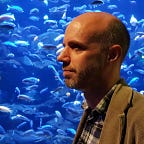‘The New World’ or — Awe and Boredom and the Malick Mix?
Maybe I’m getting tired of the cinematic grammar of wonder? You know the sort of thing — hands brushing the tips of wheat, stained glass windows shot from below whilst the camera rotates ever so slightly, starling murmurations, spinning around and making yourself dizzy (although no one ever stumbles over after doing this in a Malick film; they all must have excellent inner-ear balance). It just seems to be that every time someone has a feeling of connection with nature that this is what happens and what they must do, regardless of context or if it makes sense. And if you’re in a Terrence Malick movie it’s a fucking legal requirement.
All this pantheistic arsing about can make Malick’s characters seem very silly which can be a problem, especially when you factor in his tendency to stunt-cast (Richard Gere in the dust bowl? With THAT hair? Colin Farrell, Michael Fassbender and Ryan Gosling as deep, enigmatic mysteries? Er sure, why not!). Fortunately Malick’s endemic wheat-molestation makes a little more sense in ‘The New World’ (2005) as we are dealing with people encountering new lands plus an indigenous culture living in nature so it’s easier to forgive and makes more contextual sense if they start inexplicably feeling up the foliage.
‘The New World’ tells the story of Pocahontas and how she falls in love with Captain John Smith before finding herself in a new world of her own. What is surprising about the film is despite all the arsing about (and this movie is roughly 80% arsing about) is how quickly the story initially gets going. English ships arrive in Virginia. Here they settle and found a community. After a while their stocks begin to dwindle meaning they have a send a party out to find and trade with the locals. Mutinous Captain Smith is spared the noose if he agrees to lead the expedition. All this is done within the first twenty minutes. It’s surprisingly economical and a great example of visual story-telling.
After that it’s back to the arsing about with Captain Smith touching up the trees as he falls in love with Pocahontas and the shrubberies.
So it all boils down to how much patience you have for herbage and Wagner, which is pretty much all ‘The New World’ is. The good news is that Malick does this sort of stuff effortlessly and I find his style exceptionally easy and pleasant to experience and sit through. Sure, I get bored stiff at times, often checking how long is left, wondering if I should stop the movie and put on something else or simply letting my mind wander before I, and Malick himself, suddenly remember there’s a plot and story to tell and we’d better stop gazing at the scenery and get on with things.
What we are looking at is undeniably beautiful. Smith’s journey up the river is one of the most visually gorgeous sequences I’ve ever seen, each stunning image flowing into the next creating the experience of extended revelation. Visually ‘The New World’ is ravishing and irresistibly hypnotic.
Although this time round my attention was caught more by the sound mix which I think can explain the problem with Christopher Nolan’s mix for ‘Tenet’. Malick likes to create visual tone poems (god, I hate having to resort to that phrase) so dialogue is not so important, just the feel of what is going on. Not only that but Malick uses music in a highly sensitive manner, resulting in a highly delicate sound mix justifying Malick’s advice that you should turn it up loud for the full experience. This is because everything flutters on the cusp on the inaudible, pulling us into the picture and with no great sonic surprises in store (remember, this is the same director who used Charles Ives’ ‘The Unanswered Question’ but took all the questions out).
Nolan, a massive Malick fan, replicates the same approach, the only problem being that whilst Malick’s films are sonic oases Nolan’s movies are nothing but sonic exclamation marks meaning you have the same drive for delicacy but in the middle of explosions, battles and ear-shattering bombast. Combine that with influence of Malick’s editing — not really giving a damn about temporal continuity — and you can see just how much he influenced Nolan, and it’s all here in ‘The New World’.
I do have an issue with the soundtrack though and that’s down to James Horner’s score which, for me, is somewhat insipid, especially after the glimmering horns of Das Rheingold which open the film. Indeed, you can almost feel Malick’s relief when he gets to use Wagner again at the end and could possibly be a sign of why he decided to “do a Kubrick” and use almost only pre-existing classical music for his next film, ‘The Tree of Life’ (2011). It’s not that Horner’s score is bad as such but it doesn’t match the splendour of the visuals, feeling somewhat lacking. It sounds like the sort of music Manfred Eicher would accidentally commission for the ECM New Series if he was having a bad day or hungover.
‘The New World’ is a deeply infuriating movie in that it is both screamingly simple (the narrative unfolds with NO surprises) and thematically complex (Pocahontas as America?), tedious and captivating, stupid and profound, original and clichéd, innovative and conventional, serious and laughable. In essence, it’s typical Malick and your enjoyment will be utterly dependant on this. For me, it works… just. Although if someone touches the tips of some wheat again I’m going to fucking lose it.
